From the Steel Warriors Warbirds DVD - Douglas C-53D Skytrooper Videos
|
|
|
|
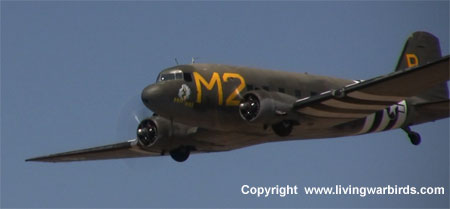 |
Manufacturer: Douglas Model: C-53D Skytrooper Year built: 1943 Serial Number: 11757 Number of Seats: 32 Number of Engines: 2 Engine Type: Turbo-prop Engine: Wright C9G C&D Series |
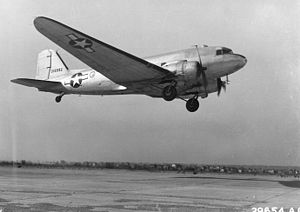 Role:
Military transport aircraft
Role:
Military transport aircraft
Manufacturer: Douglas Aircraft Company
Designed by: Douglas Aircraft
Primary users: U.S. Army Air Force, US Air Force, Royal Air Force
Number built: ;10,000
Developed from: Douglas DC-3
Variants: Lisunov Li-2, AC-47 Spooky
The Douglas C-47 Skytrain or Dakota is a military transport that was developed from the Douglas DC-3 airliner. It was used extensively by the Allies during World War II and remained in front line operations through the 1950s with a few remaining in operation to this day.
Design and development
During World War II, the armed forces of many countries used the C-47 and modified DC-3s for the transport of troops, cargo and wounded. Over 10,000 aircraft were produced in Long Beach and Santa Monica, California and Oklahoma City, Oklahoma. The Oklahoma City plant produced 5,354 C-47s from March 1943 until August 1945.
Operational history
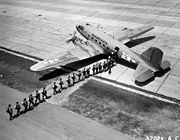 (Image: Lawson Field, Ft. Benning, Georgia)
(Image: Lawson Field, Ft. Benning, Georgia)
The C-47 was vital to the success of many Allied campaigns, in particular those at Guadalcanal and in the jungles of New Guinea and Burma where the C-47 (and its naval version, the R4D) alone made it possible for Allied troops to counter the mobility of the light-travelling Japanese army. Additionally, C-47s were used to airlift supplies to the embattled American forces during the Battle of Bastogne. But possibly its most influential role in military aviation was flying The Hump from India into China where the expertise gained would later be used in the Berlin Airlift in which the C-47 would also play its part.
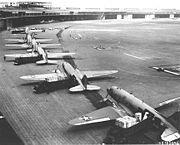 (Image: C-47s unloading at Tempelhof Airport during Berlin Airlift.)
(Image: C-47s unloading at Tempelhof Airport during Berlin Airlift.)
In Europe, the C-47 and a specialized paratroop variant, the C-53 Skytrooper, were used in vast numbers in the later stages of the war, particularly to tow gliders and drop paratroops. In the Pacific, with careful use of the island landing strips of the Pacific Ocean, C-47s were even used for ferrying soldiers serving in the Pacific theater back to the United States.
C-47s in British and Commonwealth service took the name Dakota, from the acronym "DACoTA" for Douglas Aircraft Company Transport Aircraft. The C-47 also earned the nickname Gooney Bird during the European theater of operations.
The USAF Strategic Air Command had C-47 Skytrains in service from 1946 through 1967.
After World War II the U.S. Navy also structurally modified a number of the early Navy R4D aircraft and re-designated the modified aircraft as R4D-8.
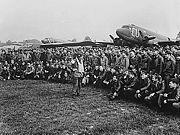 (Image: Brigadier General Anthony C. McAuliffe, artillery commander
of the 101st Airborne Division, talks to paratroopers on D-Day minus
1, behind can be seen a CG-4 Waco glider and C-47s)
(Image: Brigadier General Anthony C. McAuliffe, artillery commander
of the 101st Airborne Division, talks to paratroopers on D-Day minus
1, behind can be seen a CG-4 Waco glider and C-47s)
The C-47 was used by the Americans in the initial stages of the Berlin Airlift and was subsequently replaced by the C-54.
The US Air Force continued to use the C-47 for various roles, including the AC-47 gunships - code named Puff the Magic Dragon or Spooky - and the EC-47N for electronic reconnaissance during the Vietnam War.
The Royal Canadian Air Force also adopted the C-47 for use in search & rescue operations throughout the 1940s and 50s.
Postwar, thousands of surplus C-47s were sold and overhauled and modified for civil airline use, some remaining in operation in 2008.
Variants
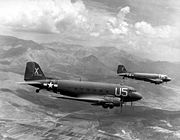 (Image: Paratroop C-47, 12th Air Force Troop Carrier Wing. Invasion
of southern France, 15 August 1944)
(Image: Paratroop C-47, 12th Air Force Troop Carrier Wing. Invasion
of southern France, 15 August 1944)
C-47
Initial military version of the DC-3 with seats for 27 troops, 965
built including 12 to the United States Navy as R4D-1.
C-47A
C-47 with a 24-volt electrical system, 5,254 built including USN
aircraft designated R4D-5.
RC-47A
C-47A equipped for photographic reconnaissance and ELINT missions.
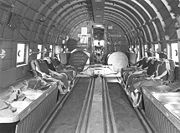 (Image: Interior view of Douglas C-47, Hendon Aerodrome, England.)
(Image: Interior view of Douglas C-47, Hendon Aerodrome, England.)
SC-47A
C-47A equipped for Search Air Rescue. Redesignated HC-47A in 1962.
VC-47A
C-47A equipped for VIP transport role.
C-47B
Powered by R-1830-90 engines with superchargers and extra fuel
capacity to cover the China-Burma-India routes, 3,364 built.
VC-47B
C-47B equipped for VIP transport role.
XC-47C
C-47 tested with Edo Model 78 floats for possible use as a seaplane.
C-47D
C-47B with superchargers removed after the war.
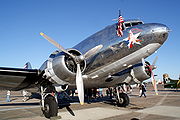 (Image: C-47B Skytrain -serial 43-49942)
(Image: C-47B Skytrain -serial 43-49942)
AC-47D
Gunship aircraft with three side-firing 7.62 mm Minigun machine
guns.
EC-47D
C-47D with equipment for the Airborne Early Warning role. Prior
to 1962 was designated AC-47D.
RC-47D
C-47D equipped for photographic reconnaissance and ELINT missions.
SC-47D
C-47D equipped for Search Air Rescue. Redesignated HC-47D in 1962.
VC-47D
C-47D equipped for VIP transport role.
C-47E
Modified cargo variant with space for 27-28 passengers or 18-24
litters.
C-47F
YC-129 re-designated, Super DC-3 prototype for evaluation by USAF
later passed to USN as XR4D-8.
C-47L/M
C-47H/Js equipped for the support of American Legation United States
Naval Attache (ALUSNA) and Military Assistance Adivsory Group (MAAG)
missions.
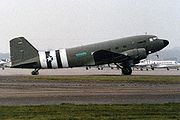 (Image: C-47 in USAAF markings with invasion stripes, Rotterdam
1985)
(Image: C-47 in USAAF markings with invasion stripes, Rotterdam
1985)
EC-47N/P/Q
C-47A and D aircraft modified for ELINT/ARDF mission. N and P
differ in radio bands covered, while Q replaces analog equipment
found on the N and P with a digital suite, redesigned antenna
equipment, and uprated engines.
C-47R
One C-47M modified for high altitude work, specifically for missions
in Ecuador.
C-47T
Designation applied to aircraft modified to a Basler BT-67 standard.
C-48
One former United Air Lines DC-3A impressed.
C-48A
Three impressed DC-3As with 18-seat interiors.
C-48B
Sixteen impressed former United Air Lines DST-As with 16-berth
interior used as air ambulances.
C-48C
Sixteen impressed DC-3As with 21-seat interiors.
C-49, C-49A, C-49B, C-49C, C-49D, C-49E, C-49F, C-49G, C-49H,
C-49J, C-49K
Various DC-3 and DST models, 138 impressed into service.
C-50, C-50A, C-50B, C-50C, C-50D
Various DC-3 models, 14 impressed.
C-51
One aircraft ordered by Canadian Colonial Airlines impressed
into service, had starboard-side door.
C-52, C-52A, C-52B, C-52C, C-52D
DC-3A aircraft with R-1830 engines, 5 impressed.
C-53 Skytrooper
Troop transport version of the C-47.
XC-53A Skytrooper
One aircraft with full-span slotted flaps and hot-air leading
edge de-icing.
C-53B Skytrooper
Winterised version of C-53 with extra fuel capacity and separate
navigator's station, eight built.
C-53C Skytrooper
C-53 with larger port-side door, 17 built.
C-53D Skytrooper
C-53C with 24V DC electrical system, 159 built.
C-68
Two DC-3As impressed with 21-seat interiors.
C-117A Skytrooper
C-47B with 24-seat airline-type interior for staff transport
use, 16 built.
VC-117A
Three redesignated C-117s used in the VIP role.
SC-117A
One C-117C converted for air-sea rescue.
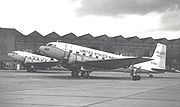 (Image:
US Navy C-117Ds at Mildenhall UK in 1967)
(Image:
US Navy C-117Ds at Mildenhall UK in 1967)
C-117B/VC-117B
High-altitude superchargers removed, one built and conversions
from C-117As all later VC-117B
C-117D
USN R4D-8 redesignated
LC-117D
USN R4D-8L redesignated
TC-117D
USN R4D-8T redesignated
VC-117D
USN R4D-8Z redesignated
YC-129
Super DC-3 prototype for evaluation by USAF redesignated C-47F
and later passed to USN as XR4D-8.
XCG-17
One C-47 tested as a 40-seat troop glider with engines removed
and faired over.
R4D-1 Skytrain
USN version of the C-47.
R4D-2
Two Eastern Air Lines DC-3s impressed into USN service as VIP
transports, later designated R4D-2F and later R4D-2Z.
R4D-3
Twenty C-53Cs transferred to USN.
R4D-4
Ten impressed DC-3s
R4D-4R
Seven impressed DC-3s as staff transports.
R4D-4Q
Radar countermeasures version of R4D-4.
R4D-5
C-47A variant 24-volt electrical system replacing the 12-volt
of the C-47. Redesignated C-47H in 1962, 238 transferred from
USAF.
R4D-5L
R4D-5 for use in Antarctica. Redesignated LC-47H in 1962.
R4D-5Q
R4D-5 for use as special ECM trainer. Redesignated EC-47H in
1962.
R4D-5R
R4D-5 for use as a personnel transport for 21 passengers and
as a trainer aicraft. Redesignated TC-47H in 1962.
R4D-5S
R4D-5 for use as a special ASW trainer. Redesignated SC-47H in
1962.
R4D-5Z
R4D-5 for use as a VIP transport. Redesignated VC-47H in 1962.
R4D-6
157 C-47Bs transferred to USN, redesignated C-47J in 1962.
R4D-6L, Q, R, S, and Z
Variants as the R4D-5 series, redesignated LC-47J, EC-47J, TC-47J,
SC-47J, and VC-47J respectively in 1962.
R4D-7
44 TC-47Bs transferred from USAF for use as a navigational trainer.
Redesignated TC-47K in 1962.
R4D-8
R4D-5 and R4D-6 aircraft fitted with modified wings and re-designed
tail surfaces, Redesignated C-117D in 1962.
R4D-8L
R4D-8 converted for Antarctic use, redesignated LC-117D in 1962.
R4D-8T
R4D-8 converted as crew trainers, redesignated TC-117D in 1962.
R4D-8Z
R4D-8 converted as a staff transport, redesignated VC-117D in
1962.
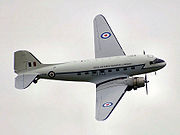 (Image: Dakota IV in RAF Transport Command colours, owned by the
UK Air Atlantique Classic Flight)
(Image: Dakota IV in RAF Transport Command colours, owned by the
UK Air Atlantique Classic Flight)
Dakota I
RAF designation for the C-47 and R4D-1
Dakota II
RAF designation for impressed DC-3s
Dakota III
RAF designation for the C-47A.
Dakota IV
RAF designation for the C-47B.
C-47TP Turbo Dakota
Refit with modern turboprop engines for SAAF
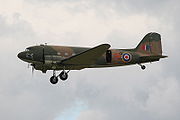 (Image: A Royal Air Force Memorial Flight Dakota with open parachute
door at Duxford, England, in 2008)
(Image: A Royal Air Force Memorial Flight Dakota with open parachute
door at Duxford, England, in 2008)
Specifications (C-47B)
General characteristics
Crew: 3
Capacity: 28 troops
Payload: 6,000 lb (2,700 kg) (8,000 lb/3,700 kg - war emergency)
Length: 63 ft 9 in (19.43 m)
Wingspan: 95 ft 6 in (29.11 m)
Height: 17 ft 0 in (5.18 m)
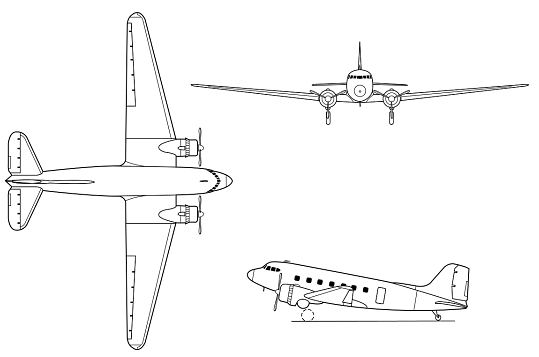 Wing area: 987 ft² (91.70 m²)
Wing area: 987 ft² (91.70 m²)
Empty weight: 17,057 lb (7,760 kg)
Loaded weight: 26,000 lb (11,800 kg)
Max takeoff weight: 31,000 lb (14,000 kg)
Powerplant: 2× Pratt & Whitney R-1830-90C "Twin Wasp" 14-cylinder radial engines, 1,200 hp (895 kW) each
Performance
Maximum speed: 224 mph (195 knots, 360 km/h)
Cruise speed: 160 mph (140 knots, 260 km/h)
Range: 1,600 mi (1,400 nm, 2,600 km)
Service ceiling 26,400 ft (8,050 m)
Rate of climb: 1,130 ft/min (5.75 m/s)
Wing loading: 26.3 lb/ft² (129 kg/m²)
Power/mass: 0.092 hp/lb (150 W/kg)
Source: WikiPedia